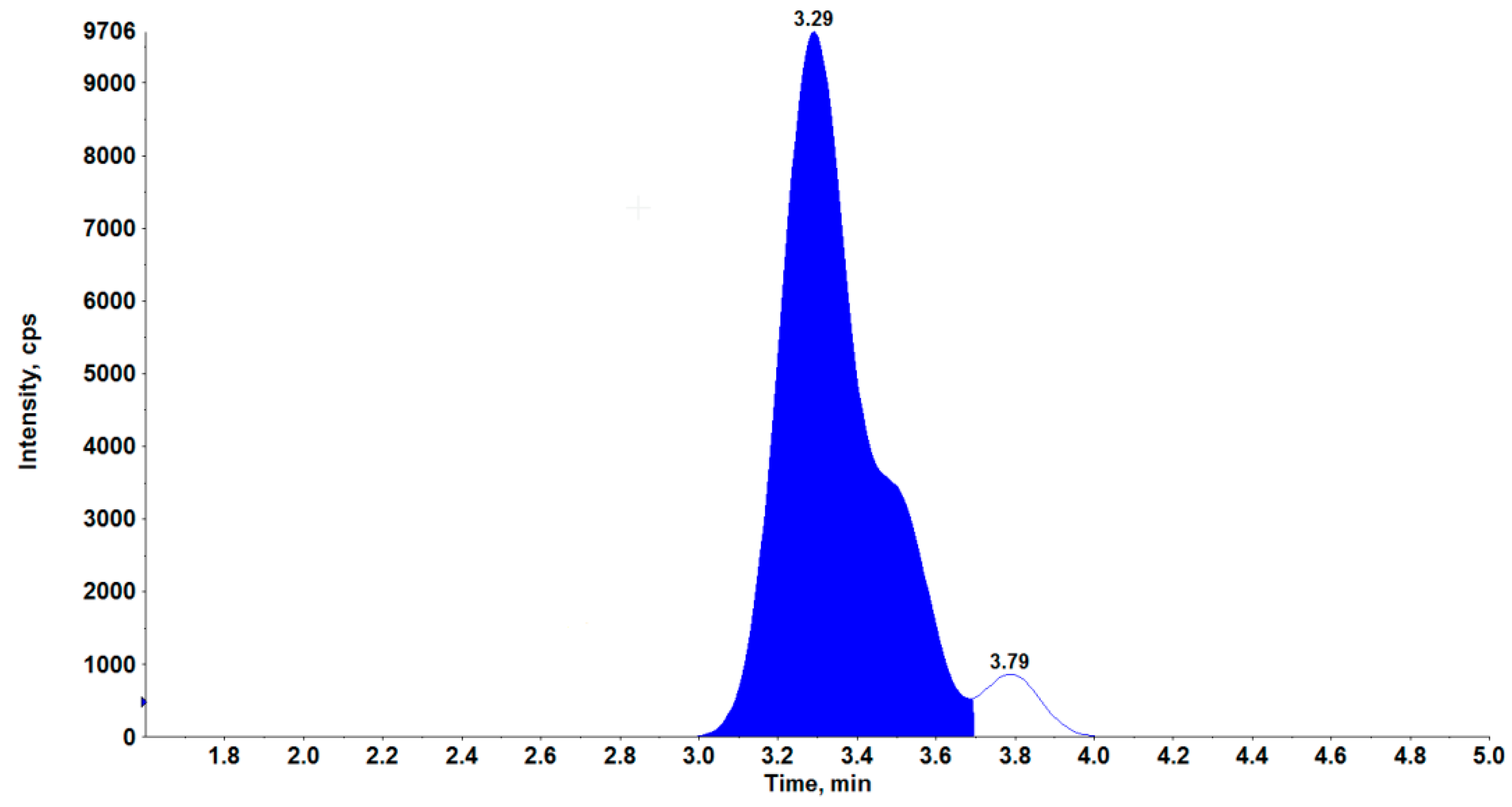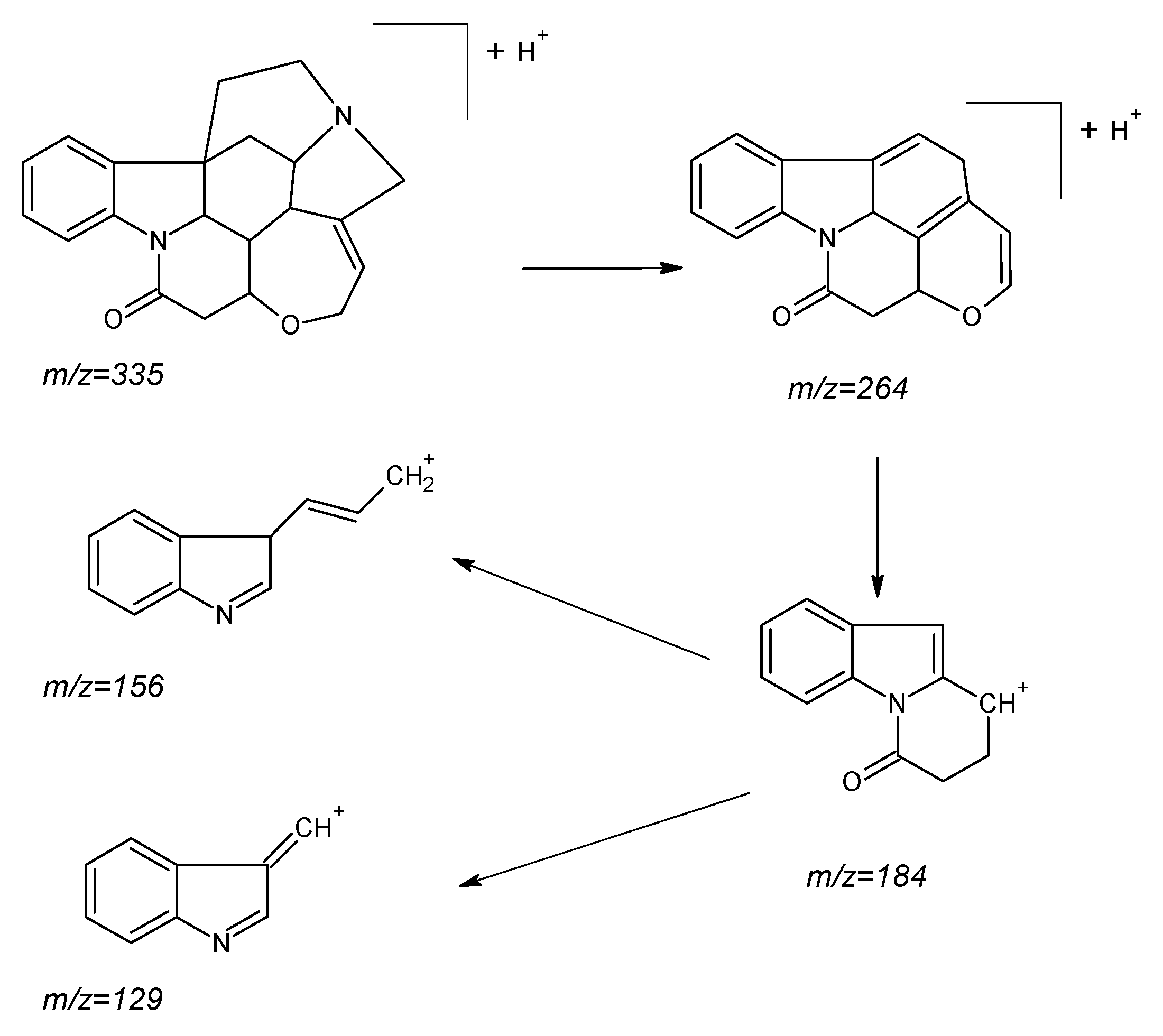The Usefulness of MS3 to Confirm Poisoning on the Example of Dog Poisoning with Strychnine
Abstract
:1. Introduction
2. Results and Discussion
3. Materials and Methods
3.1. Materials
3.2. HPLC-MS/MS/MS
3.3. Sample Preparation
3.4. Validation
4. Conclusions
Author Contributions
Funding
Acknowledgments
Conflicts of Interest
References
- Gupta, R.C. Veterinary Toxicology: Basic and Clinical Principles, 1st ed.; Elsevier: New York, NY, USA, 2007; pp. 548–550. [Google Scholar]
- Yanyan, X.; Duanyun, S.; Changxiao, L. Determination of strychnine and brucine in rat plasma using liquid chromatography electrospray ionization mass spectrometry. J. Pharm. Biomed. Anal. 2009, 49, 487–491. [Google Scholar]
- Plumlee, K.H. Clinical Veterinary Toxicology, 1st ed.; Mosby: St. Louis, MO, USA, 2004; pp. 454–456. [Google Scholar]
- Brown, P.; Charlton, A.; Cuthbert, M.; Barnett, L.; Ross, L.; Green, M. Identification of pesticide poisoning in wildlife. J. Chromatogr. A 1996, 754, 463–478. [Google Scholar] [CrossRef]
- Brown, P.M.; Turnbull, G.; Charman, S.; Charlton, A.J.; Jones, A. Analytical methods used in the United Kingdom Wildlife Incident Investigation Scheme for the detection of animal poisoning by pesticides. J. AOAC Int. 2005, 88, 204–220. [Google Scholar]
- Meiser, H. Detection of anticoagulant residues by a new HPLC method in specimens of poisoned animals and a poison control case study. J. Anal. Toxicol. 2005, 29, 556–563. [Google Scholar] [CrossRef] [PubMed]
- Wang, Y.; Kruzik, P.; Helsberg, A.; Helsberg, I.; Rausch, W.D. Pesticide poisoning in domestic animals and livestock in Austria: A 6 years retrospective study. Forensic Sci. Int. 2007, 169, 157–160. [Google Scholar] [CrossRef]
- Berny, P.; Caloni, F.; Croubels, S.; Sachana, M.; Vandenbroucke, V.; Davanzo, F. Animal poisoning in Europe. Part 2: Companion animals. Vet. J. 2010, 183, 255–259. [Google Scholar] [CrossRef]
- Luzardo, O.P.; Ruiz-Suarez, N.; Valeron, P.F.; Camacho, M.; Zumbado, M.; Henrıquez-Hernandez, L.A. Methodology for the identification of 117 pesticides commonly involved in the poisoning of wildlife using GC–MS-MS and LC–MS-MS. J. Anal. Toxicol. 2014, 38, 155–163. [Google Scholar] [CrossRef]
- Imran, M.; Shafi, H.; Wattoo, S.A.; Chaudhary, M.T.; Usman, H.F. Analytical methods for determination of anticoagulant rodenticides in biological samples. Forensic Sci. Int. 2015, 253, 94–102. [Google Scholar] [CrossRef]
- Ruiz-Suárez, N.; Boada, L.D.; Henríquez-Hernández, L.A.; González-Moreo, F.; Suárez-Pérez, A.; Camacho, M. Continued implication of the banned pesticides carbofuran and aldicarb in the poisoning of domestic and wild animals of the Canary Islands (Spain). Sci. Total Environ. 2015, 505, 1093–1099. [Google Scholar] [CrossRef]
- Sell, B.; Śniegocki, T.; Zmudzki, J.; Posyniak, A. Development of an Analytical Procedure for the Determination of Multiclass Compounds for Forensic Veterinary Toxicology. J. Anal. Toxicol. 2018, 42, 183–191. [Google Scholar] [CrossRef]
- Leuthold, L.A.; Grivet, C.; Allen, M.; Baumert, M.; Hopfgartner, G. Simultaneous selected reaction monitoring, MS/MS and MS3 quantitation for the analysis of pharmaceutical compounds in human plasma using chip-based infusion. Rapid Commun. Mass Spectrom. 2004, 18, 1995–2000. [Google Scholar] [CrossRef] [PubMed]
- Chen, J.-H.; Lee, C.-Y.; Liau, B.-C.; Lee, M.-R.; Jong, T.-T.; Chiang, S.-T. Determination of aconitine-type alkaloids as markers in fuzi (Aconitum carmichaeli) by LC/(+)ESI/MS3. J. Pharmaceut. Biomed. 2008, 48, 1105–1111. [Google Scholar] [CrossRef] [PubMed]
- Dziadosz, M. The application of multiple analyte adduct formation in the LC–MS3 analysis of valproic acid in human serum. J. Chromatogr. B. 2017, 1040, 159–161. [Google Scholar] [CrossRef] [PubMed]
- Lim, C.W.; Tai, S.H.; Lee, L.M.; Chan, S.H. Analytical method for the accurate determination of tricothecenes in grains using LC-MS/MS: A comparison between MRM transition and MS3 quantitation. Anal Bioanal Chem. 2012, 403, 2801–2806. [Google Scholar] [CrossRef]
- Richards, K.H.; Monk, R.; Renko, K.; Rathmann, D.; Rijntjes, E.; Köhrle, J. A combined LC-MS/MS and LC-MS3 multi-method for the quantification of iodothyronines in human blood serum. Anal. Bioanal. Chem. 2019, 411, 5605–5616. [Google Scholar] [CrossRef]
- Sante, E. Guidance Document on Analytical Quality Control and Method Validation Procedures for Pesticides Residues Analysis in Food and Feed. 2015 SANTE/11945/2015. Available online: http://www.eurl-pesticides.eu/library/docs/allcrl/AqcGuidance_SANTE_2015_11945.pdf (accessed on 19 October 2019).
- Chen, X.; Lai, Y.; Cai, Z. Simultaneous analysis of strychnine and brucine and their major metabolites by liquid chromatography-electrospray ion trap mass spectrometry. J. Anal. Toxicol. 2012, 36, 171–176. [Google Scholar] [CrossRef]
- Tang, P.W.; Law, W.C.; Wan, T.S.M. Analysis of corticosteroids in equine urine by liquid chromatography–mass spectrometry. J. Chromatogr. B 2001, 754, 229–244. [Google Scholar] [CrossRef]
- Mazzarino, M.; Torre, X.; Botre, F. A rapid screening LC–MS/MS method based on conventional HPLC pumps for the analysis of low molecular weight xenobiotics: Application to doping control analysis. Drug Test. Anal. 2010, 2, 311–2322. [Google Scholar] [CrossRef]
- Tian, J.-X.; Tian, Y.; Xu, L.; Zhang, J.; Lua, T.; Zhanga, Z.-J. Characterisation and Identification of Dihydroindole-type Alkaloids from Processed Semen Strychni by High-Performance Liquid Chromatography Coupled with Electrospray Ionisation Ion Trap Time-of-Flight Mass Spectrometry. Phytochem. Anal. 2014, 25, 36–44. [Google Scholar] [CrossRef]
- Haneef, J.; Shaharyar, M.; Husain, A.; Rashidan, M.; Mishra, R.; Parveen, S.; Ahmed, N.; Pal, M.; Kumar, D. Application of LC–MS/MS for quantitative analysis of glucocorticoids and stimulants in biological fluids. J. Pharm. Biomed. Anal. 2013, 3, 341–348. [Google Scholar] [CrossRef]
- Egloff, T.; Niederwieser, A.; Pfister, K.; Otten, A.; Steinmann, B.; Steiner, W.; Gitzelmann, R.J. A new high performance liquid chromatography (HPLC) method for the quantitation of strychnine in urine and tissue extracts. Clin. Chem. Clin. Biochem. 1982, 20, 203–206. [Google Scholar] [CrossRef]
- Cingolani, M.; Froldi, R.; Mencarelli, R.; Rodriguez, D. Analytical Detection and Quantitation of Strychnine in Chemically Fixed Organ Tissues. J. Anal. Toxicol. 1999, 23, 23–26. [Google Scholar] [CrossRef] [PubMed]
- Marques, E.P.; Gilb, F.; Proenc, P.; Monsantoa, P.; Oliveira, M.F.; Castanheira, A.; Vieira, D.N. Analytical method for the determination of strychnine in tissues by gas chromatography/mass spectrometry: Two case reports. Forensic Sci. Int. 2000, 110, 145–152. [Google Scholar] [CrossRef]
- Matuszewski, B.K.; Constanzer, M.L. Strategies for the assessment of matrix effect in quantitative bioanalytical methods based on HPLC-MS/MS. Anal. Chem. 2003, 1, 3019–3030. [Google Scholar] [CrossRef]
- Ellison, S.L.R.; Williams, A. Eurachem/CITAC Guide: Quantifying Uncertainty in Analytical Measurement, 3rd ed. 2012. Available online: www.eurachem.org (accessed on 30 November 2018).
Sample Availability: Samples of the compound strychnine are not available from the authors. |




| Matrix | SDL [µg/kg] | LOQ [µg/kg] | Matrix Effect (%) | Concentration Range (ng/mL) | Determination Coefficient | Calibration Curve |
|---|---|---|---|---|---|---|
| Liver | 2.0 | 25 | 5.2 ± 2.1 | 25–1000 | 0.995 | y = 0.8134(±0.04)x + 0.012(±0.06) |
| Level | Repeatability (RSDr, %) (n = 6) | Within-lab Reproducibility (RSDwR,%) (n = 18) | Apparent Recovery (%) | Expanded Uncertainty (µg/kg) |
|---|---|---|---|---|
| 25 µg/kg | 3.4 ± 3.1 | 4.6 ± 3.1 | 104.0 ± 2.8 | 25 ± 5.2 |
| 100 µg/kg | 2.9 ± 3.4 | 4.6 ± 3.3 | 103.5 ± 3.8 | 100 ± 12.3 |
| 250 µg/kg | 3.0 ± 2.7 | 3.3 ± 3.4 | 104.0 ± 4.2 | 250 ± 23.2 |
| 1000 µg/kg | 4.1 ± 2.9 | 3.7 ± 3.7 | 98.7 ± 6.3 | 1000 ± 40.8 |
| Analyte | 1st Precursor Ion (m/z) | 2nd Precursor Ion (m/z) | MS3 Ion Scan (m/z) | Width (Da) | Excitation Energy (eV) | Declustering Potential (eV) | Entrance Potential (eV) | Collision Energy (eV) |
|---|---|---|---|---|---|---|---|---|
| Strychnine | 335.2 | 184.0 | 156 129 | 1 1 | 0.1 0.1 | 290 290 | 10 10 | 61 61 |
© 2019 by the authors. Licensee MDPI, Basel, Switzerland. This article is an open access article distributed under the terms and conditions of the Creative Commons Attribution (CC BY) license (http://creativecommons.org/licenses/by/4.0/).
Share and Cite
Śniegocki, T.; Sell, B.; Posyniak, A. The Usefulness of MS3 to Confirm Poisoning on the Example of Dog Poisoning with Strychnine. Molecules 2019, 24, 3765. https://doi.org/10.3390/molecules24203765
Śniegocki T, Sell B, Posyniak A. The Usefulness of MS3 to Confirm Poisoning on the Example of Dog Poisoning with Strychnine. Molecules. 2019; 24(20):3765. https://doi.org/10.3390/molecules24203765
Chicago/Turabian StyleŚniegocki, Tomasz, Bartosz Sell, and Andrzej Posyniak. 2019. "The Usefulness of MS3 to Confirm Poisoning on the Example of Dog Poisoning with Strychnine" Molecules 24, no. 20: 3765. https://doi.org/10.3390/molecules24203765
APA StyleŚniegocki, T., Sell, B., & Posyniak, A. (2019). The Usefulness of MS3 to Confirm Poisoning on the Example of Dog Poisoning with Strychnine. Molecules, 24(20), 3765. https://doi.org/10.3390/molecules24203765






